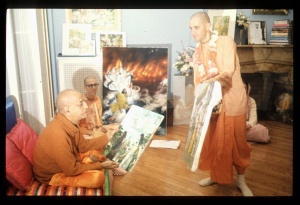SB 1.16.11: Difference between revisions
m (1 revision(s)) |
(Vanibot #0020: VersionCompareLinker - added a link to the Version Compare feature) |
||
| Line 1: | Line 1: | ||
{{info | {{info | ||
|speaker= | |speaker=Sūta Gosvāmī | ||
|listener=Sages of | |listener=Sages of Naimiṣāraṇya | ||
}} | }} | ||
[[Category:Srimad-Bhagavatam - Canto 01 Chapter 16]] | |||
[[Category:Bhagavatam Verses Spoken by Suta Gosvami - Vanisource|011611]] | |||
<div style="float:left">'''[[Srimad-Bhagavatam]] - [[SB 1|First Canto]] - [[SB 1.16: How Pariksit Received the Age of Kali|Chapter 16: How Parīkṣit Received the Age of Kali]]'''</div> | |||
<div style="float:right">[[File:Go-previous.png|link=SB 1.16.10]] '''[[SB 1.16.10]] - [[SB 1.16.12]]''' [[File:Go-next.png|link=SB 1.16.12]]</div> | |||
{{CompareVersions|SB|1.16.11|SB 1965|SB 1972-77}} | |||
{{RandomImage}} | |||
==== TEXT 11 ==== | ==== TEXT 11 ==== | ||
<div class="verse"> | |||
<div | :svalaṅkṛtaṁ śyāma-turaṅga-yojitaṁ | ||
svalaṅkṛtaṁ śyāma-turaṅga-yojitaṁ | :rathaṁ mṛgendra-dhvajam āśritaḥ purāt | ||
rathaṁ mṛgendra-dhvajam āśritaḥ purāt | :vṛto rathāśva-dvipa-patti-yuktayā | ||
vṛto rathāśva-dvipa-patti-yuktayā | :sva-senayā digvijayāya nirgataḥ | ||
sva-senayā digvijayāya nirgataḥ | |||
</div> | </div> | ||
| Line 18: | Line 23: | ||
==== SYNONYMS ==== | ==== SYNONYMS ==== | ||
<div class="synonyms"> | |||
<div | ''su-alaṅkṛtam''—very well decorated; ''śyāma''—black; ''turaṅga''—horses; ''yojitam''—tackled; ''ratham''—chariot; ''mṛga-indra''—lion; ''dhvajam''—flagged; ''āśritaḥ''—under the protection; ''purāt''—from the capital; ''vṛtaḥ''—surrounded by; ''ratha''—charioteers; ''aśva''—cavalry; ''dvipapatti''—elephants; ''yuktayā''—thus being equipped; ''sva-senayā''—along with infantry; ''digvijayāya''—for the purpose of conquering; ''nirgataḥ''—went out. | ||
su- | |||
</div> | </div> | ||
| Line 26: | Line 30: | ||
==== TRANSLATION ==== | ==== TRANSLATION ==== | ||
<div class="translation"> | |||
<div | |||
Mahārāja Parīkṣit sat on a chariot drawn by black horses. His flag was marked with the sign of a lion. Being so decorated and surrounded by charioteers, cavalry, elephants and infantry soldiers, he left the capital to conquer in all directions. | Mahārāja Parīkṣit sat on a chariot drawn by black horses. His flag was marked with the sign of a lion. Being so decorated and surrounded by charioteers, cavalry, elephants and infantry soldiers, he left the capital to conquer in all directions. | ||
</div> | </div> | ||
| Line 34: | Line 37: | ||
==== PURPORT ==== | ==== PURPORT ==== | ||
<div class="purport"> | |||
<div | |||
Mahārāja Parīkṣit is distinguished from his grandfather Arjuna, for black horses pulled his chariot instead of white horses. He marked his flag with the mark of a lion, and his grandfather marked his with the mark of Hanumānjī. A royal procession like that of Mahārāja Parīkṣit surrounded by well-decorated chariots, cavalry, elephants, infantry and band not only is pleasing to the eyes, but also is a sign of a civilization that is aesthetic even on the fighting front. | Mahārāja Parīkṣit is distinguished from his grandfather Arjuna, for black horses pulled his chariot instead of white horses. He marked his flag with the mark of a lion, and his grandfather marked his with the mark of Hanumānjī. A royal procession like that of Mahārāja Parīkṣit surrounded by well-decorated chariots, cavalry, elephants, infantry and band not only is pleasing to the eyes, but also is a sign of a civilization that is aesthetic even on the fighting front. | ||
</div> | </div> | ||
__NOTOC__ | |||
<div style="float:right; clear:both;">[[File:Go-previous.png|link=SB 1.16.10]] '''[[SB 1.16.10]] - [[SB 1.16.12]]''' [[File:Go-next.png|link=SB 1.16.12]]</div> | |||
__NOTOC__ | |||
__NOEDITSECTION__ | |||
Revision as of 09:48, 25 May 2020

A.C. Bhaktivedanta Swami Prabhupada
TEXT 11
- svalaṅkṛtaṁ śyāma-turaṅga-yojitaṁ
- rathaṁ mṛgendra-dhvajam āśritaḥ purāt
- vṛto rathāśva-dvipa-patti-yuktayā
- sva-senayā digvijayāya nirgataḥ
SYNONYMS
su-alaṅkṛtam—very well decorated; śyāma—black; turaṅga—horses; yojitam—tackled; ratham—chariot; mṛga-indra—lion; dhvajam—flagged; āśritaḥ—under the protection; purāt—from the capital; vṛtaḥ—surrounded by; ratha—charioteers; aśva—cavalry; dvipapatti—elephants; yuktayā—thus being equipped; sva-senayā—along with infantry; digvijayāya—for the purpose of conquering; nirgataḥ—went out.
TRANSLATION
Mahārāja Parīkṣit sat on a chariot drawn by black horses. His flag was marked with the sign of a lion. Being so decorated and surrounded by charioteers, cavalry, elephants and infantry soldiers, he left the capital to conquer in all directions.
PURPORT
Mahārāja Parīkṣit is distinguished from his grandfather Arjuna, for black horses pulled his chariot instead of white horses. He marked his flag with the mark of a lion, and his grandfather marked his with the mark of Hanumānjī. A royal procession like that of Mahārāja Parīkṣit surrounded by well-decorated chariots, cavalry, elephants, infantry and band not only is pleasing to the eyes, but also is a sign of a civilization that is aesthetic even on the fighting front.